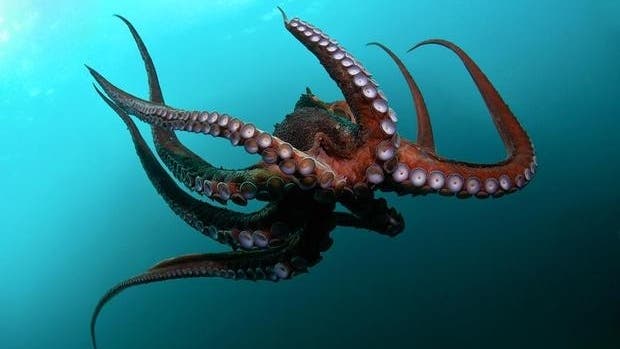Octopus species that live in ice-cold Antarctic waters employ an unique strategy to transport oxygen to its tissue and survive, according to German researchers. The study suggests the octopuses’ specialized pigments, analogous to hemoglobin in vertebrates, are in higher concentration in the Antarctic region than in warmer waters. This would help to explain why octopuses are more adapted to climate change and warming waters.

Antarctic octopuses survive in cold waters by holding higher concentrations of blue blood proteins. Image: National Geographic
Despite the inhospitable temperatures, the Antarctic waters host a wide variety of marine fauna. That’s mostly because the waters already contain diffused oxygen which helps compensate for the lower oxygen transport resulting from more viscous blood and lower tissue diffusion. This is why Antarctic icefish, for instance, don’t need hemoglobin at all – the iron-rich protein that cells use to bind and ferry oxygen through the circulatory system from heart to lungs to tissues and back again. They’re the only vertebrates that don’t use hemoglobin. The adaptive measures employed by blue-blooded octopods to sustain oxygen supply in the cold are less understood, however.
Michael Oellermann from Alfred-Wegener-Institute, Germany, and colleagues studied the Antarctic octopus Pareledone charcoti, as well as two other warm water species: the South-east Australian Octopus pallidus and the Mediterranean Eledone moschata. Octopods have not one, but three hearts, and instead of hemoglobin use a blue blood pigment called haemocyanin. The researchers found Pareledone charcoti had 40% haemocyanins than the other warm water species. The researchers say that these high blood pigment concentrations may be compensating for the haemocyanin’s poor ability to release oxygen to tissues while in cold environments, and could help to ensure sufficient oxygen supply. Findings appeared in Frontiers in Zoology.
“This is important because it highlights a very different response compared to Antarctic fish to the cold conditions in the Southern Ocean. The results also imply that due to improved oxygen supply by haemocyanin at higher temperatures, this octopod may be physiologically better equipped than Antarctic fishes to cope with global warming,” Oellermann said.
For instance, the octopuses – including the cold hearted Pareledone charcoti – were found to shuttle haemocyanin much better at temperatures of 10 degrees Celsius than at zero degrees. At 10°C the Antarctic octopod’s haemocyanin had the potential to release far more oxygen (on average 76.7%) than the warm-water octopods Octopus pallidus (33.0%) and Eledone moschata (29.8%). The Antarctic Peninsula is currently experiencing a warming trend from which Pareledone charcoti might benefit, seeing how it’s already well adapted.
This is the first study providing clear evidence that the octopods’ blue blood pigment, haemocyanin, undergoes functional changes to improve the supply of oxygen to tissue at sub-zero temperatures. It might be why octopods remain so populous across a wide spectrum of ecological niches.









